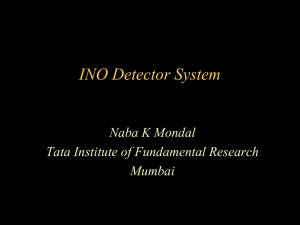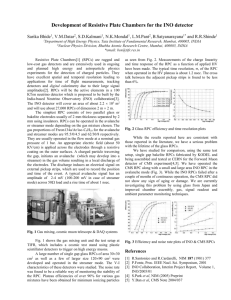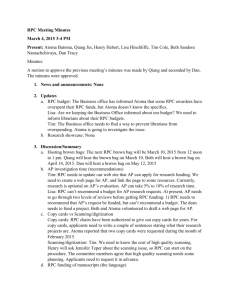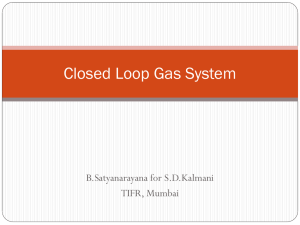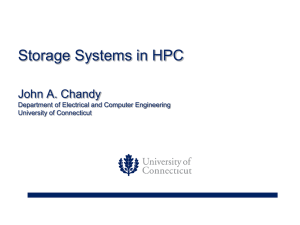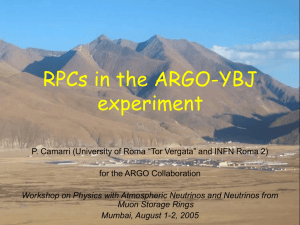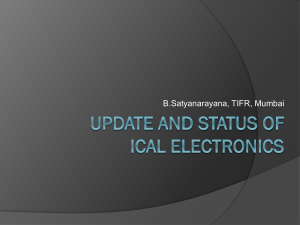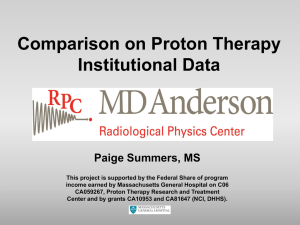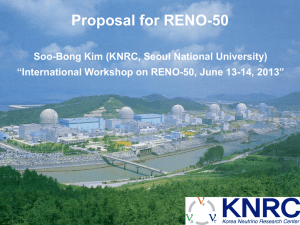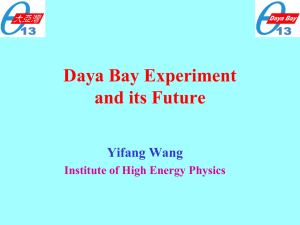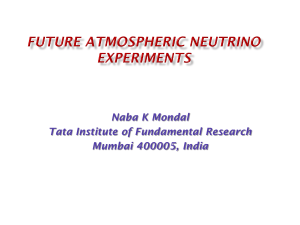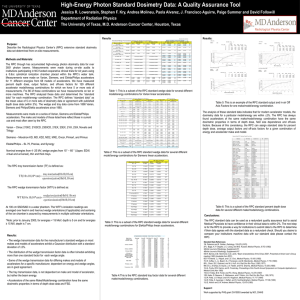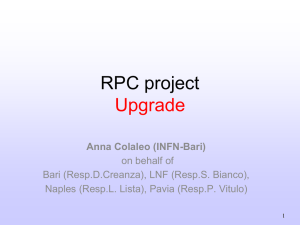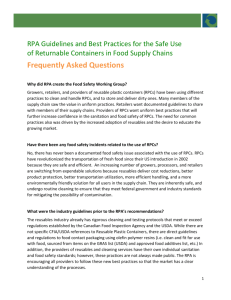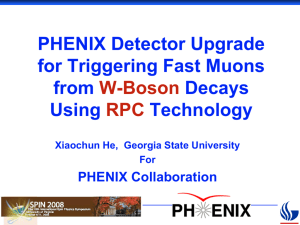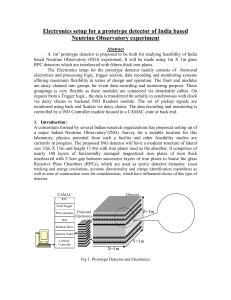ppt
advertisement
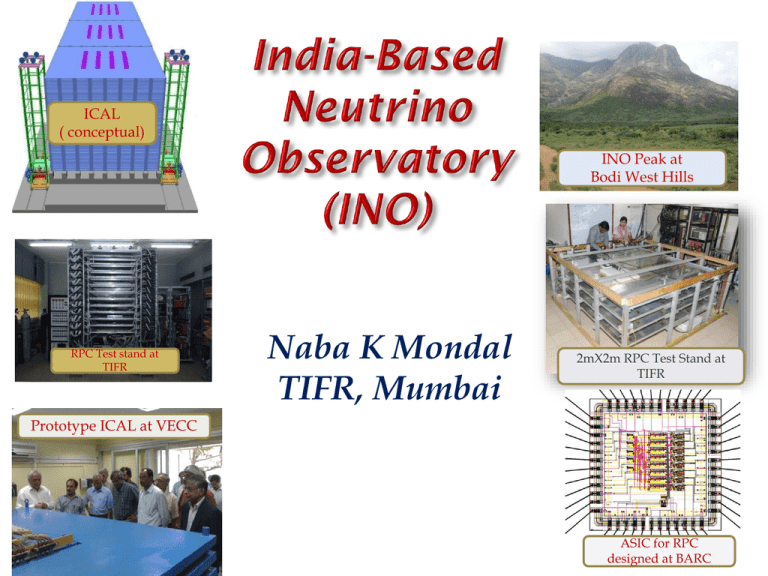
ICAL ( conceptual) INO Peak at Bodi West Hills RPC Test stand at TIFR Naba K Mondal TIFR, Mumbai 2mX2m RPC Test Stand at TIFR Prototype ICAL at VECC ASIC for RPC designed at BARC India had a long tradition of carrying out experiments deep underground. KGF laboratory was the deepest underground laboratory during the period 1951-1992. First atmospheric neutrino was detected at KGF at a depth of 2.3km way back in 1965 by the TIFROsaka-Durham group. During late 70s & early 80s dedicated detectors were setup at KGF by TIFR-Osaka collaboration to look for proton decay. KGF mines closed its operation in 1992. Physics Letters 18, (1965) 196, dated 15th Aug 1965 Atmospheric neutrino detector at Kolar Gold Field –1965 PRL 15, (1965), 429, dated 30th Aug. 1965 Underground laboratory with ~1 km all-round rock cover accessed through a 2 km long tunnel. A large and several smaller caverns to facilitate many experimental programmes. Frontline neutrino issues e.g., mass parameters and other properties, will be explored in a manner complementary to ongoing efforts worldwide. The ICAL detector, with its charge identification ability, will be able to address questions about the neutrino mass ordering. Distance from CERN (Switzerland) and JPARC (Japan) ~ 7000 km, close to “magic baseline” for experiments with neutrino beams in a few decade from now Will support several other experiments when operational. Neutrino-less Double Beta Decay and Dark Matter Search experiments foreseen in the immediate future. INO facility will be available for international community for setting up experiments. Ahmedabad: Physical Research Laboratory (PRL); Aligarh: Aligarh Muslim University (AMU); Allahabad: Harish Chandra Research Institute (HRI); Calicut : University of Calicut; Chandigarh: Panjab University (PU); Chennai : Indian Institute of Technology, Madras (IITM); Chennai : The Institute of Mathematical Sciences (IMSc) ; Delhi : Delhi University (DU); Guwahati : Indian Institute of Technology (IITG); Hawaii (USA) : University of Hawaii (UHW); Indore: Indian Institute of Technology (IITInd); Jammu : University of Jammu (JU) ; Kalpakkam : Indira Gandhi Center for Atomic Research (IGCAR); Kolkata : Ramakrishna Mission Vivekananda University (RMVU); Kolkata : Saha Institute of Nuclear Physics (SINP); Kolkata : University of Calcutta (CU) ; Kolkata : Variable Energy Cyclotron Centre (VECC) ; Lucknow : Lucknow University (LU); Madurai : American College; Mumbai : Bhabha Atomic Research Centre (BARC) ; Mumbai : Indian Institute of Technology, Bombay (IITB) ; Mumbai : Tata Institute of Fundamental Research (TIFR); Mysore : University of Mysore (MU) ; Sambalpur : Sambalpur University; Srinagar : University of Kashmir; Varanasi : Banaras Hindu University (BHU) Construction of an underground laboratory and surface facilities near Pottipuram village in Theni district of Tamil Nadu. Construction of the 50 kton magnetised Iron calorimeter (ICAL) detector to study properties of neutrinos. Construction of the INO centre- The National Centre for High Energy Physics (NCHEP) at Madurai. Human Resource Development ( INO Graduate Training Program) Detector R & D 10 A large mass detector with charge identification capability Physics goal: • Improved measurement of oscillation parameters. • Search for potential matter effect in neutrino oscillation. • Determining the sign of Dm223 using matter effect • Measuring deviation from maximal mixing for q23 • Probing CP and CPT violation. • Constraining long range leptonic forces. • Ultra high energy neutrinos and muons. νμ The disappearance probability can be measured with a single detector and two equal sources: N up(L/E) = P(nm nm; L/E) N down(L’/E) = 1 - sin2 (2Q) sin2 (1.27 Dm2 L/E) R. Gandhi et al PRL 94, 051801, 2005 13 Blennow & Schwetz 2012 Blennow & Schwetz 2012 7000 KM No of modules Module dimension Detector dimension No of layers Iron plate thickness Gap for RPC trays Magnetic field RPC unit dimension Readout strip width No. of RPCs/Road/Layer No. of Roads/Layer/Module No. of RPC units/Layer Total no of RPC units No of Electronic channels 3 16 m X 16 m X 12 m 48 m X 16 m X 12 m 140 6 cm 2.5 cm 1.5 Tesla 2mX2m 2 cm 8 8 192 27000 3.6 X 106 18 2 mm thick spacer Two 2 mm thick float Glass Separated by 2 mm spacer Pickup strips Glass plates Resistive coating on the outer surfaces of glass 20 No of modules Module dimension Detector dimension No of layers Iron plate thickness Gap for RPC trays Magnetic field RPC unit dimension Readout strip width No. of RPCs/Road/Layer No. of Roads/Layer/Module No. of RPC units/Layer Total no of RPC units No of Electronic channels 3 16 m X 16 m X 12 m 48 m X 16 m X 12 m 140 6 cm 2.5 cm 1.5 Tesla 2mX2m 2 cm 8 8 192 27000 3.6 X 106 21 22 23 25 26 VME BASED DAQ SETUP X strip data Analog Front End Y strip data RPC Stack Digital Front End Trigger Module Timing info Event/ Monitor Data VME CRATE Scaler TDC Event Trigger Readout Module Linux based DAQ software (C++, Qt, ROOT) Interrupt Based Multi-Threaded Graphical User Interface Online 2D/3D Event Display RPC Strip Monitoring Online Error Reporting 27 28 Strip Multiplicity due to crossing muons Track residue in mm Strip noise rate vs time Image of a RPC using muons Muon flux measurement at sea level & at lower latitude (180 N) General muon flux distribution Iq I 0 cosn q n=2.15 ± 0.01 I0 = (6.217 ± 0.005)×10-3 cm-2 s-1 str-1 MisIdentified Peak: ~1.0 For a constant time resolution of 1.5 ns for all layers, 1s for time fit slope for a vertical track is ~0.3. Data gives 1s = 0.326 for ndf>2. This says misidentification in directionality is ~0.3% within 5s limit Prototype Magnet & RPC setup at VECC, Kolkata 32 33 Gas flow for five RPCs (2m×2m) in new lab is reduced to 0.29 SCCM (1 volume change per 19 days). Long-term performance studies on these RPCs is in progress. At present, gas flow for the RPC (1mx1m) stack in C217 lab is 2.25 SCCM (1.6 volume change per day ) i.e. 1 volume change per 0.62 days. 34 35 36 37 38 39 Simulation Framework NUANCE Neutrino Event Generation Output: νa+ X -> A + B + ... Generates particles that result from a random interaction of a neutrino with matter using theoretical models . i) Reaction Channel ii) Vertex Information Iii) Energy & Momentum of all Particles Event Simulation GEANT4 A + B + ... through RPCs + Mag.Field Simulate propagation of particles through the detector (RPCs + Magnetic Field) Output: i) x,y,z,t of the particles at their interaction point in detector ii) Energy deposited iii) Momentum information Event Digitisation Output: (x,y,z,t) of A + B + ... + noise + detector efficiency Add detector efficiency and noise to the hits i) Digitised output of the previous stage (simulation) Event Reconstruction Output: (E,p) of ν + X = (E,p) of A + B + ... Fit the tracks of A + B + ... to get their energy and momentum. i) Energy & Momentum of the initial neutrino 40 Trigger criteria based on event topology alone. Distributed and hierarchical architecture. Detector module segmented to generate local trigger. Combination of local triggers produces global trigger. Global trigger latches event data. Muon events and neutrino events are generated with event vertices randomly distributed over the fiducial volume of the detector. µ Events Events are simulated using the INO-ICAL simulation code and the Digitization output is used to determine the trigger efficiency. Analysis algorithm complies with the architecture of the trigger system. Trigger efficiency is determined for Segment size 4m x 4m x 4m. Trigger criteria 1x5/8 2x4/8 3x3/8 4x2/8 CC ν Events Magnet simulation |B| ≥ 1 T Region where |B| ≥ 1 T is ~ 87% Surface plot of |B| 43 INO Training School: We have already started INO graduate training program from August 2008. Affiliated to HBNI. At present INO students are being trained for one year at TIFR, Mumbai in both experimental techniques and theory. Being attached to Ph.D. guides at various collaborating institutions for a Ph. D. degree after completion of coursework 2009 2008 44 RPC development Electronics Prototype magnet at VECC/SINP, Kolkata is running. 2nd Engineering module will be fabricated during next 2 years. Human Resource First batch of ASIC front end designed by the INO electronics team and fabricated by Euro Practice IC Services being tested in the lab using RPC pulses. Magnet Full size RPCs (2m X 2m) are now being fabricated not only in our lab but also by the Industry. Graduate Training Programme for the last three years within HBNI INO SiteEnvironment & Forest clearances obtained. 26 Hectares of land at Pottipuram provided by TN Govt. free of cost. 12 Hectares at Madurai will be provided by TN Govt. against payment. PERT CHART 46 Thank You Thank you 47
